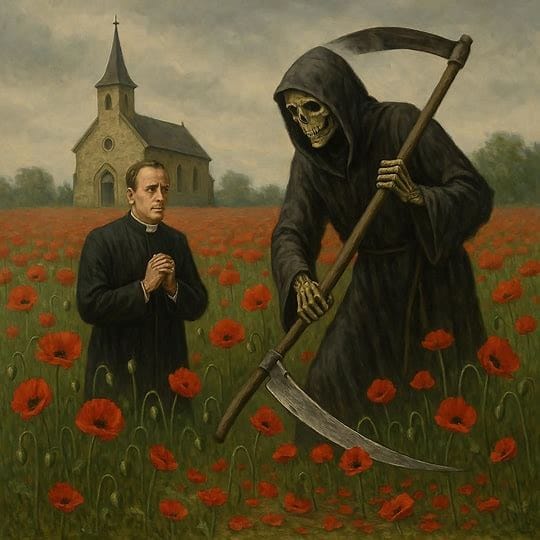Socialism and the Tall Poppy Syndrome

"What is driving the Scythe? Your Envy, Their Pride!" Doug Garland
From Harold Evans's The American Century:
Between 1900 and 1910, 9 million people came from abroad, just about the entire population of the country in 1820, and very few spoke English. As Robert Benchley put it, "We call England the mother country because most of us come from Poland or Italy." New York had more Italians than Rome, more Jews than Warsaw, more Irish than Dublin, and already more blacks than any other city in the world. Fully one seventh of the population of the United States in 1910 was foreign-born.
America, with some 80 million people, was on the way to becoming the most powerful country in the world, but its wealth had not trickled down much, and in the biggest cities, the immigrants were crowded with the poor in a squalor unsurpassed anywhere in the West.
There were nearly 4,000 millionaires in America when Teddy Roosevelt went to the White House in 1901. They represented less than one ten-thousandth of 1 percent of the population, but they had acquired 20 percent of the wealth. The distortion was not as extreme as in Britain, but one half of America's wealth was owned by 1 percent of the families.
The Red Scare of the 1920s—often called the First Red Scare—was a period in the United States shortly after World War I marked by intense fear of communism, socialism, anarchism, and radical leftist ideologies. It lasted roughly from 1917 to 1920.
Several factors fueled this widespread panic. The 1917 Bolshevik Revolution in Russia and the rise of communist governments in Europe led many Americans to fear a similar revolution might happen in the U.S. A wave of labor strikes and unrest after World War I, such as the 1919 Seattle General Strike and the Boston Police Strike, which were often portrayed as being inspired by radicals or foreign agitators. Contributing to these fears were anarchist bombings, including attempts on the lives of public officials such as Attorney General A. Mitchell Palmer.
In response, the U.S. government launched a series of raids (known as the Palmer Raids) on suspected radical organizations, arresting thousands and deporting hundreds, especially immigrants considered politically subversive. The climate of suspicion led to violations of civil liberties, including unwarranted arrests and limits on free speech.
The social environment was also affected by anti-immigrant sentiment and nativism, with recent immigrants, particularly from Southern and Eastern Europe, viewed with distrust. The Red Scare dissipated mainly by the summer of 1920, as the predicted uprisings failed to materialize and public opinion turned against the more extreme measures taken by the government.
The Second Red Scare was a period of intense fear and suspicion of communism and leftist ideology, lasting from the late 1940s through the mid-1950s. This era, often called "McCarthyism" after Senator Joseph McCarthy, was marked by accusations that communists and Soviet sympathizers had infiltrated the federal government, entertainment industry, academia, and other sectors of American society.
Key features and events of the Second Red Scare included: the start of the Cold War, with its rising tensions between the U.S. and the Soviet Union; congressional investigations, loyalty programs, and public hearings targeted individuals suspected of communist affiliations; the infamous "blacklisting" of artists, writers, and actors in Hollywood and elsewhere; and McCarthy's highly publicized, aggressive tactics accusing government officials and others of communist ties, particularly peaking with the "McCarthy hearings" of 1954.
While few actual spies were uncovered, many people's careers and reputations were destroyed based on often-unfounded accusations. The period ended as public opinion turned against the extreme tactics used during the investigations and as McCarthy himself was discredited.
Today, the top 0.001% (also known as the top 0.1% of the top 1%) has an income threshold exceeding $50 million per year and includes roughly 1,300 households. They contribute about 5-10% of the total federal income taxes, while the top 0.1% pay around 25%, and the top 1% cover about 42%.
The top 1% hold about 35% of the wealth, the top 10% hold roughly 70%, and the bottom 90% have around 30%. This is the elephant in the room and needs solutions.
Democratic socialism is a political and economic philosophy that combines the principles of democracy with social ownership and broad social welfare. It's distinct from both traditional socialism and capitalism. No country is fully democratic socialist; many have adopted elements of it, especially in Scandinavia.
The ultimate goal of democratic socialism is a society where democracy extends to both politics and the economy, prioritizing social welfare, economic fairness, and reducing inequality — while preserving individual rights and political freedom.
"Harrison Bergeron" is a short story by Tall Poppy Kurt Vonnegut Jr. and part of his collection of short stories in Welcome to the Monkey House. The plot is set in a dystopian future America in 2081, where the government has achieved complete equality by forcing everyone to be handicapped down to the level of the least capable person. Intelligent people wear mental handicap devices that disrupt their thoughts, strong people carry heavy weights, and beautiful people wear masks or are disfigured.
The story centers on George and Hazel Bergeron, whose son, Harrison, the government has imprisoned because his exceptional abilities made him too dangerous to society's enforced equality. Harrison is remarkably tall, strong, intelligent, and handsome—everything the society aims to suppress.
Harrison eventually escapes from prison and interrupts a televised ballet performance, declaring himself emperor and removing his handicaps along with those of a ballerina. Together they perform a beautiful, transcendent dance that represents human potential unleashed. However, their moment of freedom is brief - the Handicapper General, Diana Moon Glampers, arrives and shoots them both dead on live television.
The tale ends with George and Hazel watching this tragedy unfold on TV, but due to their mental handicaps, they quickly forget what they've seen and return to their mundane conversation.
The story acts as a sharp satire of misguided egalitarianism and warns about the dangers of enforcing equality of outcome instead of equality of opportunity. Vonnegut examines themes of individuality, freedom, the importance of excellence, and the risk of totalitarian control disguised as social progress.
America doesn't need a new kind of government, but virtuous leaders to uphold its principles. Our Founding Fathers understood that people are prone to wrongdoing, which is why they established three branches of government as checks and balances. We only need our politicians to do their jobs.
Perhaps the time has come for an updated version of Jacob Riis's How the Other Half Lives (1890).
I have completed writing my new book, Sin to Virtue: Transforming The Tall Poppy Syndrome by Understanding The Seven Deadly Sins. Here is a look https://youtu.be/C7RjTXdpHvE
Tall Poppy Syndrome Newsletter
Join the newsletter to receive the latest updates in your inbox.



